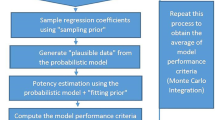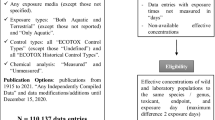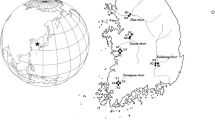Abstract
When the field of aquatic toxicity testing began its first major expansion about 40 years ago, it was uncommon to use more than one test species (usually a fish). Later, it became customary to use individual microorganisms (usually algae) and macroinvertebrates as well. Most attention was then given to the response of the most sensitive species in that test series when calculating the ‘biologically safe’ concentration acceptable for use in natural systems. However, in recent years, there has been an attempt to equate the most sensitive species in a laboratory test series to the most sensitive species in natural systems. Since laboratory test species represent only a tiny part of natural systems and since response variability is well established, that can be a dangerous assumption. The purpose of this discussion is to re-examine the scientific support for this practice.
Similar content being viewed by others
References
Bentley, R. E., J. W. Dean, S. J. Ells, G. A. LeBlanc, S. Sauter & B. J. Sleight, III., 1976. Laboratory evaluation of the toxicity of nitroglycerine to aquatic organisms. US Army Med. Res. Dev. Command. Contract #DAMD-17-74-C-4101.
Cairns, J., Jr., 1983. Are single species toxicity tests alone adequate for estimating hazard? Hydrobiologia 100: 47–57.
Cairns, J., Jr., 1986a. What is meant by validation of predictions based on laboratory toxicity tests? Hydrobiologia 137: 271–278.
Cairns, J., Jr., 1986b. Multispecies toxicity testing: a new information base for hazard evaluation. Curr. Prac. Envir. Sci. Eng. 2: 37–49.
Carlson, A. R., H. Nelson & D. Hammermeister, 1986. Development and validation of site-specific water quality criteria for copper. Envir. Toxicol. Chem. 5: 997–1012.
Crossland, N. O., 1984. Fate and biological effects of methyl parathion in outdoor and laboratory aquaria. Ecotoxicol. Envir. Saf. 8: 482–495.
Crossland, N. O. & C. J. M. Wolff, 1985. Fate and biological effects of pentachlorophenol in outdoor ponds. Envir. Toxicol. Chem. 4: 73–86.
Geckler, J. R., W. B. Horning, T. M. Neiheisel, Q. H. Pickering, E. L. Robinson & C. E. Stephan, 1976. Validity of laboratory tests for predicting copper toxicity in streams. EPA-600/3-76-116. National Technical Information Service, Springfield, Virginia.
Giesy, J. P., 1985. Multispecies tests: Research needs to assess the effects of chemicals on aquatic life. In R. C. Bahner & D. J. Hansen (eds), Aquatic Toxicology and Hazard Assessment: Eighth Symposium, STP 891. American Society for Testing and Materials, Philadelphia: 67–77.
Giddings, J. M., 1986. A microcosm procedure for determining safe levels of chemical exposure in shallow-water communities. In J. Cairns, Jr. (ed), Community Toxicity Testing, STP 920. American Society for Testing and Materials, Philadelphia: 121–134.
Giddings, J. M. & P. J. Franco, 1985. Calibration of laboratory bioassays with results from microcosms and ponds. In T. P. Boyle (ed), Validation and Predictability of Laboratory Methods for Assessing the Fate and Effects of Contaminants in Aquatic Ecosystems, STP 865. American Society for Testing and Materials, Philadelphia: 104–119.
Hansen, S. R. & R. R. Garton, 1982. Ability of standard toxicity tests to predict the effects of the insecticide diflubenzuron on laboratory stream communities. Can. J. Fish. Aquat. Sci. 39: 1273–1288.
Hedtke, S. F., 1984. Structure and function of copper-stressed aquatic microcosms. Aquat. Toxicol. 5: 227–244.
Kimball, K. D. & S. A. Levin, 1985. Limitations of laboratory bioassays: the need for ecosystem-level testing. BioScience 35: 165–171.
Livingston, R. J., R. J. Diaz & D. C. White, 1985. Field validation of laboratory-derived multispecies aquatic test systems. EPA-600/4-85-039. National Technical Information Service, Springfield, Virginia.
Mayer, F. L., P. M. Mehrle & R. A. Schoettger, 1977. Collagen metabolism in fish exposed to organic chemicals. In R. A. Tubb (ed), Recent Advances in Fish Toxicology. EPA-600/3-77-085. National Technical Information Service, Springfield, Virginia: 31–54.
Mosser, J. L., N. S. Fisher & C. F. Wurster, 1972. Polychlorinated biphenyls and DDT alter species composition in mixed cultures of algae. Science 176: 533–535.
Mount, D. I., 1985. Scientific problems in using multispecies toxicity tests for regulatory purposes. In J. Cairns, Jr. (ed), Multispecies Toxicity Testing. Pergamon Press, NY: 13–18.
Mount, D. I., N. A. Thomas, T. J. Norberg, M. T. Barbour, T. H. Roush & W. F. Brandes, 1984. Effluent and ambient toxicity testing and instream community response on the Ottawa River, Lima, Ohio. EPA-600/3-84-080. National Technical Information Service, Springfield, Virginia.
Niederlehner, B. R., J. R. Pratt, A. L. Buikema & J. Cairns, Jr., 1985. Laboratory tests evaluating the effects of cadmium on freshwater protozoan communities. Envir. Toxicol. Chem. 4: 155–165.
Niederlehner, B. R., J. R. Pratt, A. L. Buikema & J. Cairns, Jr., 1986. Comparison of estimates of hazard derived at three levels of complexity. In J. Cairns, Jr. (ed), Community Toxicity Testing, STP 920. American Society for Testing and Materials, Philadelphia: 30–48.
Odum, E. P., 1984. The mesocosm. BioScience 34: 558–562.
O'Neill, R. V. & J. B. Waide, 1981. Ecosystem theory and the unexpected: Implications for environmental toxicology. In B. W. Cornaby (ed), Management of Toxic Substances in our Ecosystem. Ann Arbor Science, Ann Arbor: 43–73.
Perez, K. T. & G. E. Morrison, 1985. Environmental assessments from simple test systems and a microcosm: comparisons of monetary costs. In J. Cairns, Jr. (ed), Multispecies Toxicity Testing. Pergamon Press, NY: 89–95.
Portier, P. J., 1985. Comparison of environmental effect and biotransformation of toxicants on laboratory microcosm and field microbial communities. In T. P. Boyle (ed), Validation and Predictability of Laboratory Methods for Assessing the Fate and Effects of Contaminants in Aquatic Ecosystems, STP 865. American Society for Testing and Materials, Philadelphia: 14–30.
Seegert, G., J. A. Fava & P. M. Cumbie, 1985. How representative are the data sets used to derived national water quality criteria. In R. D. Cardwell, R. Purdy & R. C. Bahner (eds), Aquatic Toxicology and Hazard Assessment: Seventh Symposium, STP 854. American Society for Testing and Materials, Philadelphia: 527–537.
Sheehan, P. J., R. P. Axler & R. C. Newhook, 1986. Evaluation of simple generic aquatic ecosystem tests to screen the ecological impacts of pesticides. In J. Cairns, Jr. (ed), Community Toxicity Testing, STP 920. American Society for Testing and Materials, Philadelphia: 158–179.
Stephan, C. E., D. I. Mount, D. J. Hansen, J. H. Gentile, G. A. Chapman & W. A. Brungs, 1985. Guidelines for deriving numerical national water quality criteria for the protection of aquatic organisms and their uses. US Environmental Research Laboratories, Duluth, Minnesota.
Sullivan, J. F., G. J. Atchison, D. J. Kolar & A. W. McIntosh, 1978. Changes in the predator-prey behavior of fathead minnows (Pimephales promelas) and largemouth bass (Micropterus salmoides) caused by cadmium. J. Fish. Res. Bd Can. 35: 446–451.
Tagatz, M. E., 1986. Some methods for measuring effects of toxicants on laboratory- and field-colonized estuarine benthic communities. In J. Cairns, Jr. (ed), Community Toxicity Testing, STP 920, American Society for Testing and Materials, Philadelphia: 18–29.
Taub, F. B., A. C. Kindig & L. L. Conquest, 1986. Preliminary results of interlaboratory testing a a standardized aquatic microcosms. In J. Cairns, Jr. (ed), Community Toxicity Testing, STP 920. American Society for Testing and Materials, Philadelphia: 93–120.
Van Voris, P., D. A. Tolle, M. F. Arthur & J. Chesson, 1985. Terrestrial microcosms: Applications, validation, and cost-benefit analysis. In J. Cairns, Jr. (ed), Multispecies Toxicity Testing. Pergamon Press, NY: 117–142
Weis, J. S., 1985. Letters to the editor: species in ecosystems. BioScience 35: 330.
Author information
Authors and Affiliations
Rights and permissions
About this article
Cite this article
Cairns, J., Niederlehner, B.R. Problems associated with selecting the most sensitive species for toxicity testing. Hydrobiologia 153, 87–94 (1987). https://doi.org/10.1007/BF00005507
Received:
Revised:
Accepted:
Issue Date:
DOI: https://doi.org/10.1007/BF00005507




